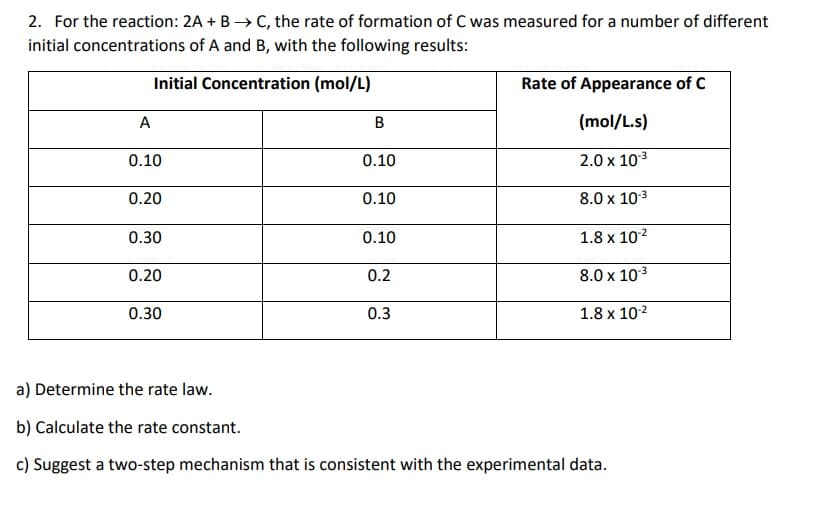2. For the reaction: 2A + B→ C, the rate of formation of C was measured for a number of different initial concentrations of A and B, with the following results: Initial Concentration (mol/L) Rate of Appearance of C A В (mol/L.s) 0.10 0.10 2.0 x 103 0.20 0.10 8.0 x 103 0.30 0.10 1.8 x 102 0.20 0.2 8.0 x 103 0.30 0.3 1.8 x 102 a) Determine the rate law. b) Calculate the rate constant. c) Suggest a two-step mechanism that is consistent with the experimental data.
2. For the reaction: 2A + B→ C, the rate of formation of C was measured for a number of different initial concentrations of A and B, with the following results: Initial Concentration (mol/L) Rate of Appearance of C A В (mol/L.s) 0.10 0.10 2.0 x 103 0.20 0.10 8.0 x 103 0.30 0.10 1.8 x 102 0.20 0.2 8.0 x 103 0.30 0.3 1.8 x 102 a) Determine the rate law. b) Calculate the rate constant. c) Suggest a two-step mechanism that is consistent with the experimental data.
Chemistry & Chemical Reactivity
9th Edition
ISBN:9781133949640
Author:John C. Kotz, Paul M. Treichel, John Townsend, David Treichel
Publisher:John C. Kotz, Paul M. Treichel, John Townsend, David Treichel
Chapter14: Chemical Kinetics: The Rates Of Chemical Reactions
Section: Chapter Questions
Problem 12PS: The reaction 2 NO(g) + 2 H2(g) N2(g) + 2 H2O(g) was studied at 904 C, and the data in the table...
Related questions
Question
100%
phy chem q2

Transcribed Image Text:2. For the reaction: 2A + B → C, the rate of formation of C was measured for a number of different
initial concentrations of A and B, with the following results:
Initial Concentration (mol/L)
Rate of Appearance of C
A
В
(mol/L.s)
0.10
0.10
2.0 x 103
0.20
0.10
8.0 x 103
0.30
0.10
1.8 x 102
0.20
0.2
8.0 x 103
0.30
0.3
1.8 x 102
a) Determine the rate law.
b) Calculate the rate constant.
c) Suggest a two-step mechanism that is consistent with the experimental data.
Expert Solution
This question has been solved!
Explore an expertly crafted, step-by-step solution for a thorough understanding of key concepts.
Step by step
Solved in 3 steps with 2 images

Knowledge Booster
Learn more about
Need a deep-dive on the concept behind this application? Look no further. Learn more about this topic, chemistry and related others by exploring similar questions and additional content below.Recommended textbooks for you

Chemistry & Chemical Reactivity
Chemistry
ISBN:
9781133949640
Author:
John C. Kotz, Paul M. Treichel, John Townsend, David Treichel
Publisher:
Cengage Learning

Chemistry & Chemical Reactivity
Chemistry
ISBN:
9781337399074
Author:
John C. Kotz, Paul M. Treichel, John Townsend, David Treichel
Publisher:
Cengage Learning

Chemistry
Chemistry
ISBN:
9781305957404
Author:
Steven S. Zumdahl, Susan A. Zumdahl, Donald J. DeCoste
Publisher:
Cengage Learning

Chemistry & Chemical Reactivity
Chemistry
ISBN:
9781133949640
Author:
John C. Kotz, Paul M. Treichel, John Townsend, David Treichel
Publisher:
Cengage Learning

Chemistry & Chemical Reactivity
Chemistry
ISBN:
9781337399074
Author:
John C. Kotz, Paul M. Treichel, John Townsend, David Treichel
Publisher:
Cengage Learning

Chemistry
Chemistry
ISBN:
9781305957404
Author:
Steven S. Zumdahl, Susan A. Zumdahl, Donald J. DeCoste
Publisher:
Cengage Learning

Chemistry: An Atoms First Approach
Chemistry
ISBN:
9781305079243
Author:
Steven S. Zumdahl, Susan A. Zumdahl
Publisher:
Cengage Learning


Chemistry for Engineering Students
Chemistry
ISBN:
9781337398909
Author:
Lawrence S. Brown, Tom Holme
Publisher:
Cengage Learning